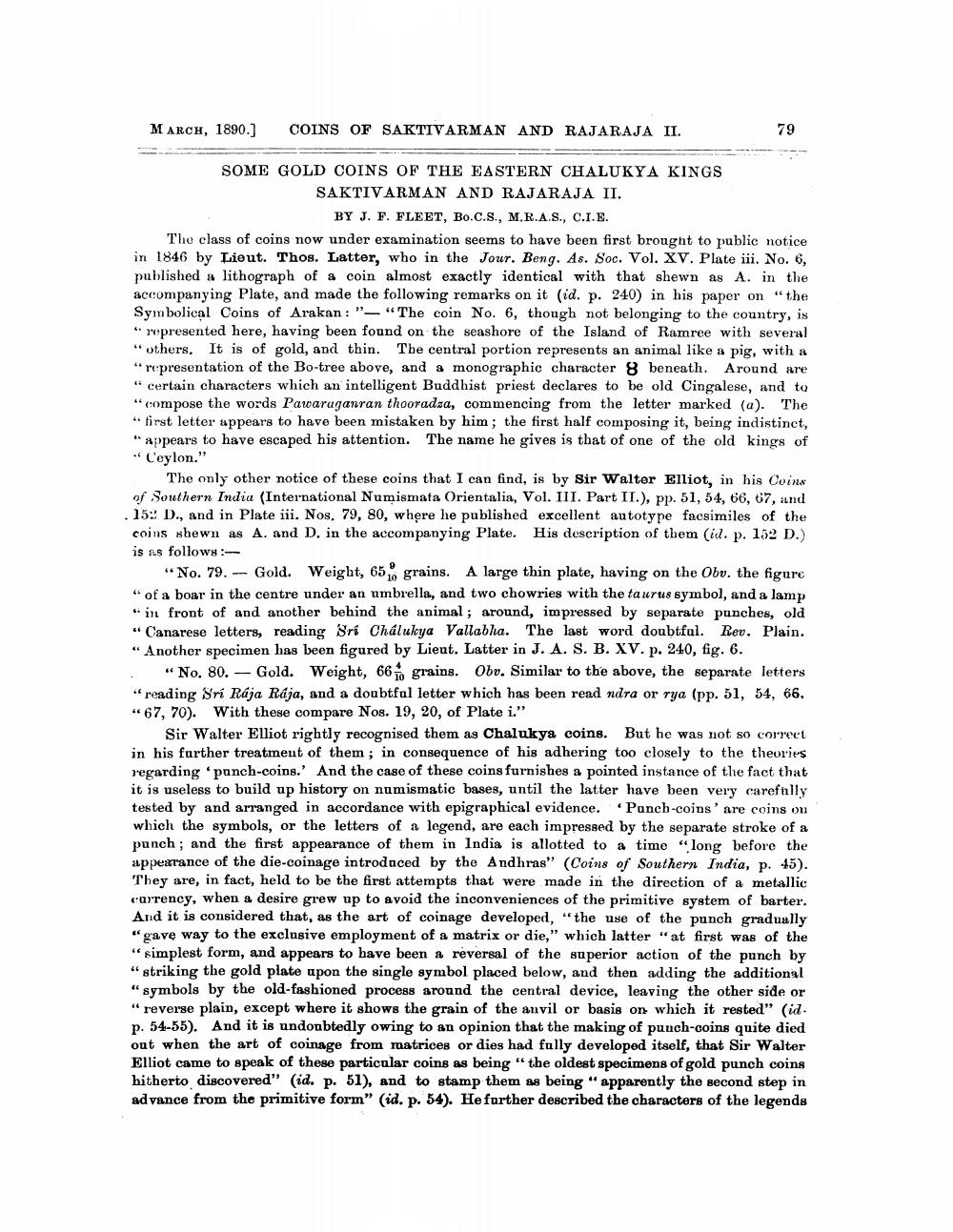________________
MARCH, 1890.)
COINS OF SAKTIVARMAN AND RAJARAJA II.
79
SOME GOLD COINS OF THE EASTERN CHALUKYA KINGS
SAKTIV ARMAN AND RAJARAJA II.
BY J. F. FLEET, Bo.C.S., M.R.A.S., C.I.E. The class of coins now under examination seems to have been first brought to public notice in 1846 by Lieut. Thos. Latter, who in the Jour. Beng. As. Soc. Vol. XV. Plate iii. No. 6, published a lithograph of a coin almost exactly identical with that shewn as A. in the accompanying Plate, and made the following remarks on it (id. p. 240) in his paper on "the Symbolical Coins of Arakan:"-"The coin No. 6, though not belonging to the country, is * represented here, having been found on the seashore of the Island of Ramree with several "others. It is of gold, and thin. The central portion represents an animal like a pig, with a " representation of the Bo-tree above, and a monographic character 8 beneath. Around are " certain characters which an intelligent Buddhist priest declares to be old Cingalese, and to **compose the words Pawaraganran thooradza, commencing from the letter marked (a). The - first letter appears to have been mistaken by him; the first half composing it, being indistinct,
appears to have escaped his attention. The name he gives is that of one of the old kings of "Ceylon."
The only other notice of these coins that I can find, is by Sir Walter Elliot, in his Coins of Southern India (International Numismata Orientalia, Vol. III. Part II.), pp. 51, 54, 66, 67, and . 15: D., and in Plate iii. Nos. 79, 80, where he published excellent autotype facsimiles of the
coins shewn as A. and D. in the accompanying Plate. His description of them (id. p. 152 D.) is as follows:
"No. 79. - Gold. Weight, 650 grains. A large thin plate, having on the Obv. the figure * of a boar in the centre under an umbrella, and two chowries with the taurus symbol, and a lamp " in front of and another behind the animal; around, impressed by separate punches, old “ Canarese letters, reading Sri Chalukya Vallabla. The last word doubtful. Rev. Plain. "Another specimen has been figured by Lieut. Latter in J. A. S. B. XV. p. 240, fig. 6.
"No. 80. - Gold. Weight, 6610 grains. Obv. Similar to the above, the separate letters reading Sri Raja Raja, and a doubtful letter which has been read ndra or rya (pp. 51, 54, 66. « 67, 70). With these compare Nos. 19, 20, of Plate i."
Sir Walter Elliot rightly recognised them as Chalukya coins. But he was not so correct in his further treatment of them ; in consequence of his adhering too closely to the theories regarding panch-coins. And the case of these coins furnishes a pointed instance of the fact that it is useless to build up history on numismatic bases, until the latter have been very carefully tested by and arranged in accordance with epigraphical evidence. Panch-coins' are coins on which the symbols, or the letters of a legend, are each impressed by the separate stroke of a punch; and the first appearance of them in India is allotted to a time "long before the appearance of the die-coinage introduced by the Andhras" (Coins of Southern India, p. 45).
They are, in fact, held to be the first attempts that were made in the direction of a metallic currency, when a desire grew up to avoid the inconveniences of the primitive system of barter. And it is considered that, as the art of coinage developed, "the use of the punch gradually "gave way to the exclusive employment of a matrix or die," which latter "at first was of the "simplest form, and appears to have been a reversal of the superior action of the punch by "striking the gold plate upon the single symbol placed below, and then adding the additional "symbols by the old-fashioned process around the central device, leaving the other side or " reverse plain, except where it shows the grain of the anvil or basis on which it rested" (id. p. 54-55). And it is undoubtedly owing to an opinion that the making of punch-coins quite died out when the art of coinage from matrices or dies had fully developed itself, that Sir Walter Elliot came to speak of these particular coins as being "the oldest specimens of gold punch coins hitherto discovered" (id. p. 51), and to stamp them as being "apparently the second step in advance from the primitive form" (id. p. 54). He further described the characters of the legends




